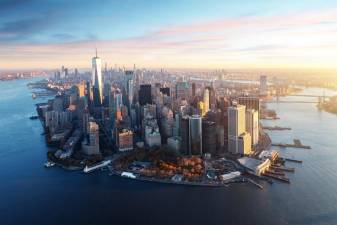What If Schoolyards Stayed Open?
UWS Council Member Gale Brewer is fighting to reinvigorate a program that turns schoolyards to public playgrounds, open outside of regular school hours

Schoolyards in all five boroughs boast precious outdoor real estate, with a catch: an overwhelming number aren’t open beyond regular school hours, or to those who aren’t students. Upper West Side Council Member Gale Brewer is betting that revisiting an old initiative — former Mayor Michael Bloomberg’s 2007 “Schoolyards to Playgrounds” program — could change the landscape.
“This is a no-brainer,” said Carl Mahaney, a co-director of the advocacy group StreetopiaUWS. “The land is sitting here.” On Tuesday morning, he stood with Brewer and a crowd of fellow supporters on West 84th Street outside of P.S. 9, which is among the many schools in the city to only open its yard to students during the day.
Of the city’s 940 school buildings with outdoor yards, tallied during the 2019-2020 school year, only 260 are already part of the program, the New York City Independent Budget Office (IBO) informed Brewer in mid-October. The Council member, in collaboration with BetaNYC, unveiled an interactive map of schoolyard locations on Tuesday, revealing a complete lack of schoolyards open in the evenings, on weekends or during school breaks on the Upper West Side, two schoolyards in the program on the Upper East Side, a lone location in Chelsea and a smattering Downtown. “People need open space more than ever,” Brewer said.
The Great Outdoors
Outdoor refuge isn’t always easy to come by — and it’s not always so close to home. In a city of millions, there are only 2.4 playgrounds for every 10,000 people, “and very limited space to build new ones,” Brewer said on Tuesday. Opportunity lies instead where outdoor spaces for play already exist.
Linda Cooper, an Upper West Side resident, said she’s fought for more than 20 years for the schoolyard at P.S. 9, the Sarah Anderson School, to remain open beyond regular school hours.
Access to the outdoors is “important for mental and physical health,” said Carter Strickland, who serves as the New York State director for the Trust for Public Land, a nonprofit. During the COVID-19 pandemic, that connection only became more widely recognized.
Next Steps
After writing to the IBO, Brewer’s office received an estimate that it would cost $67,000 each day to keep 680 schoolyards — those not currently open to the public — operational for three hours after school during the week; it would cost $180,000 per day on weekends.
Maintaining pristine and looked-after playgrounds, which the IBO cited as accounting for the cost of additional hours of operation, is essential, proponents suggested on Tuesday. “We need funding for custodians,” Strickland said. “These are supervised parks — that keeps them safe, that keeps them clean.” Brewer’s next step will be bringing legislation forward in the City Council.
Schoolyards that are already part of the program prove it’s more than a welcome change in New York City neighborhoods, she said. “They’re absolutely packed.”
“This is a no-brainer.” Carl Mahaney, co-director of StreetopiaUWS
